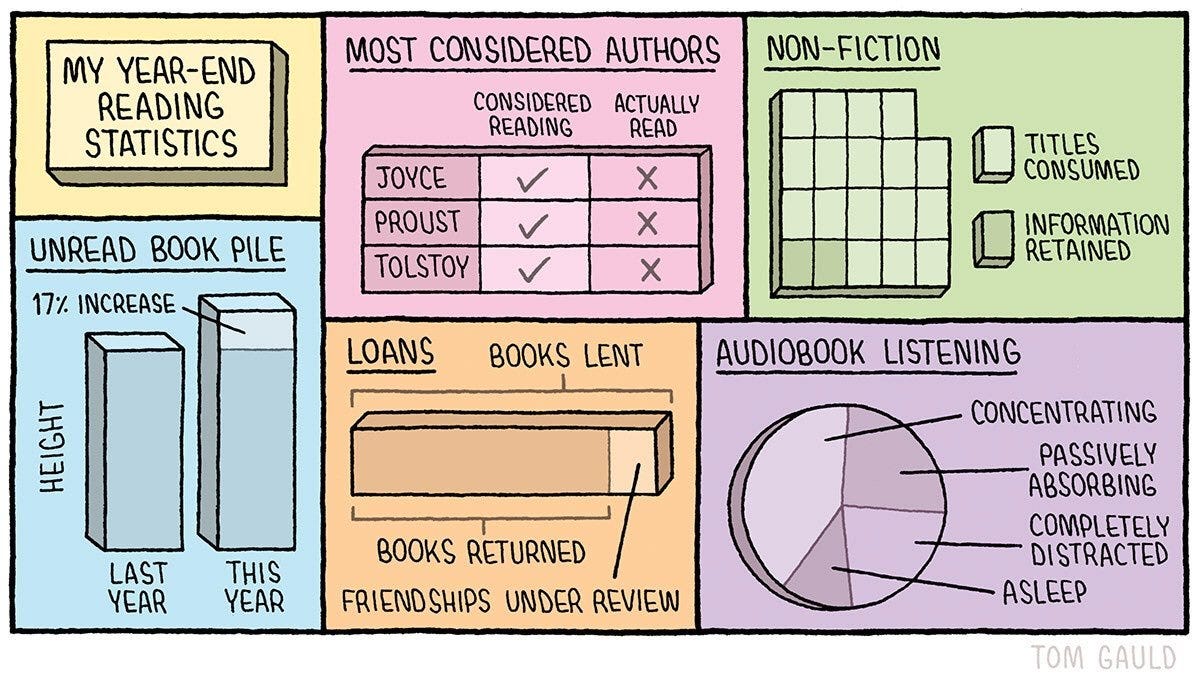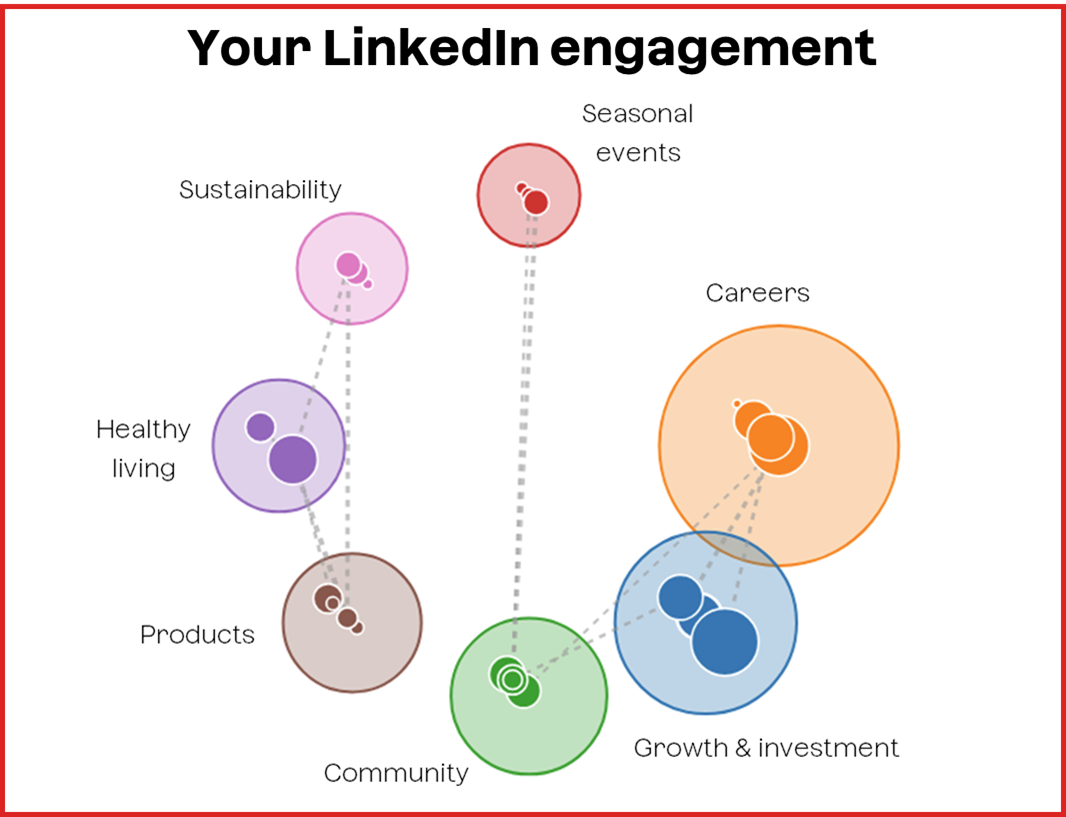A meme I identify with every time - a large pile of books on a bedside table, waiting patiently to be read.
I currently have three books on the go:
Norman Mailer’s The Naked And The Dead (on loan from the library after it was mentioned in Mad Men)
Sally Rooney’s Beautiful World, Where Are You (which I’m enjoying but honestly am struggling to finish. I find Rooney’s will-they/won’t-they relationships far too real, meaning I simultaneously want and don’t want to know what will happen)
Stephen King’s Salem’s Lot (which I’m re-reading after watching two pretty terrible adaptations)
That’s on top of a bunch of tabs, PDFs and links I’ve yet to explore.
In short, there’s always too much to read. But that’s also part of the fun. It can honestly feel daunting NOT to have anything to read. No new book cued up, an inbox empty of newsletters - mildly terrifying scenarios both. Give me a surplus over a deficit every day.
Sometimes, though, particularly when I’m behind on my newsletters, I’m guilty of not reading for enjoyment, but scanning to spot potential subjects to write about. This most often happens while lying on my daughter’s floor, in between encouraging her to go to sleep (and stopping her from standing up or completely upending her sheets).
When my dominant thought is “could I write about this?”, I risk missing less obvious nuggets that could indeed become the jumping off point for an article. A case in point is the Matt on Audio piece on the RAJAR numbers I referenced last week. I nearly deleted it, but I forced myself into a curious reading mode, stumbled on the Avril Lavigne stats, and that was that.
I find I can get into similar one track mind mindsets when listening to music - sometimes it’s a constant filter of “should I put this on a mixtape?” (my friend James runs a chat where we take it in turns to share a five-track Spotify playlist. I take my submissions very seriously), or “could I learn to play this on the guitar?”. Again, it removes an element of enjoyment from the experience.
Modern tech doctrines would suggest that I could reclaim the enjoyment of reading and listening to music by outsourcing some of the occasionally dominant tasks to the machine.
I could easily get ChatGPT or Claude to summarise newsletters, links and research reports for me when the weight of information threatens to topple over.
I could get Spotify to auto-suggest playlists and use a mix of YouTube and ChatGPT to suggest songs to learn on guitar that suit my tastes and skill level.
But honestly, that’s no fun.
I enjoy reading, I enjoy writing, I enjoy coming up with ideas for playlists, I enjoy the wonky, more serendipitous route I take to learning songs.
And the process is still essential, particularly when it comes to reading.
Philosopher Arthur Schopenhauer was of a similar opinion:
“You may accumulate a vast amount of knowledge but it will be of far less value to you than a much smaller amount if you have not thought it over for yourself; because only through ordering what you know by comparing every truth with every other truth can you take complete possession of your knowledge and get it into your power.”
(Quote sourced from Shane Parrish’s Farnam Street weekly email newsletter, which I always make the time to read).
I’m not sure how Schopenhauer would have handled modern agency life. Still, you can be sure that he probably would have had limited time for commissioning generic “research” packs that inevitably never get read by anyone.
It’s the act of doing the research, of using outside sources and information to spark thoughts, that’s important.
It doesn’t have to rely on reading - speaking to experts, conducting focus groups with target audiences, undertaking an audience safari, getting hands-on with a product or service, and unearthing nuggets on YouTube. These are all equally valid methods of the most critical act of research - immersing yourself in the world of the brief or your client.
It’s the act of immersion that sparks ideas and trains of thought that often lead to smart strategic answers and compelling creative solutions. Sometimes the immersion is swift and simple; other times it can feel fraught and meandering. But either way, it’s essential - even in an era where the temptation can be to fully outsource the process.
A deep research summary from ChatGPT is often a great starting point, particularly if you’re coming to a challenge or industry completely fresh. But utilising generative AI to support your research and immersion can and should be so much more than “summarise this PDF for me” (a summary that, for me, generally lacks the thought-provoking impact of reading something yourself).
I’ve used genAI in a variety of ways to support the research and planning process. A particular favourite is using the machine’s capabilities to analyse larger datasets, such as a selection of LinkedIn or other social media posts.
For a recent new biz process, I scraped five retailers’ LinkedIn posts into an Excel file. I then uploaded the file to ChatGPT and Claude, and used the software to identify all the posts relating to sustainability (providing guardrails on how I defined sustainability in this context).
I was then able to immerse myself in the world of those retailers’ sustainability posts and get a handle on which topics and campaigns generated the most engagement. I was also able to identify that fabled “white space” where the prospect could stand out from the crowd.
As ever, when using genAI, you need to check your results - hence using both ChatGPT and Claude to try and identify any major clangers in the outputs. But it’s a tangible example of a task that would take a human a long time (manually tagging a couple of hundred LinkedIn posts) sped up by a tool, with an error rate that’s relatively low stakes.
Similarly, Rob Estreitinho over at Salmon Labs (and the man who initially introduced me to the links between planning and philosophy) advocates using genAI to support cultural research. Specifically, creator-led videos on YouTube. You can read his full process here, but it’s surprisingly simple - just scrape a bunch of transcripts, put them in a document, PDF it, and then upload it to ChatGPT or Claude. Then, ask the questions you’re interested in learning about, immersing yourself in your specific YouTube culture without having to summarise all the videos manually.
As the models and capabilities improve, your options for using genAI to support your research and immersion into your chosen industry or problem will also improve. I’ve used Claude for data visualisation (mapping out topics within a specific conversation, such as homelessness), and seen first-hand how it’s gone from “shonky” to “PowerPoint-ready” in the space of a few months.
But the fundamental principle remains the same - don’t fully outsource the research process, either to the machine or junior members of the team. That will inevitably only give you the surface-level information (x pieces of coverage, x amount of X mentions).
If you want to go deeper, to find the interesting nuggets that inevitably spark new ideas and thinking, you need to get your hands metaphorically dirty. Identify the patterns and routes that work for you, so you can easily go back to them in stressful, clutch pitch moments. Think about the kind of research and immersion you’d love to do, but lack the time for, and then see if you can get a piece of software to help make that happen.
But remember to keep the emphasis on “help”, on using the machine as a tool, not as a crutch.
You might love to have more time to read more books - it’s not worth outsourcing the reading part. You might get through your pile quicker, but it’s still a bad cover version of reading.



